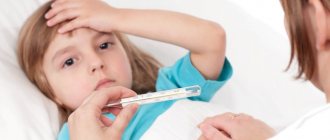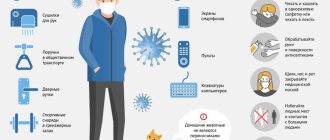A seemingly unreasonable increase in temperature in a child always becomes a cause for concern for parents. Even if the fever is not accompanied by typical symptoms of a cold or poisoning, it still indicates that not everything is in order with the baby’s body. Fever without symptoms in a child can be associated with various diseases and pathological conditions. To understand the cause of the elevated temperature, you need to consult a doctor. In any case, if the thermometer rises to 38 °C, or the baby feels unwell even in mild heat, it is important to alleviate his condition with the help of an age-appropriate drug. MAXICOLD® for CHILDREN1 can be used as such a remedy.
Why is fever dangerous in children, and how to deal with it?
advises a medical pediatrician. Fever is the most common sign of the development of infectious and some other diseases in children.
Many things can cause a child to have a fever, from common childhood illnesses such as chicken pox and tonsillitis to reactions to vaccinations. An increase in body temperature is an innate protective mechanism by which the body stimulates the functioning of the protective factors of the immune system. Also, the increased temperature of the internal environment of the body itself can lead to inactivation or death of pathogens of many diseases. Remember that everyone's body temperature normally fluctuates 1-2 degrees throughout the day and may vary depending on age, activity level and other factors.
So rising temperatures are not a “problem.” This is an indicator that some kind of attack by microbes, viruses or other factors has occurred on the body, and the body reacts to it, gives a “response”. It is much worse when bacteria or viruses attack, but the temperature does not rise (i.e. there is no immune response, or it is insufficient).
From 2 to 6 years
After 2 years, children's contacts with the outside world significantly expand: they begin to attend kindergarten and educational clubs. Changes in the immune system occur. Babies are protected by passive immunity received from the mother. Gradually its protective properties decrease. These changes cause frequent incidence of infectious diseases.
Childhood infections
Rubella, measles, chicken pox, scarlet fever become more frequent after 2-3 years: children begin to attend kindergarten, where they can come into contact with infected people who do not yet have a rash. The first sign of infection is a high temperature in a child without symptoms. After some time, a rash appears: finely spotted, confluent, pink, pale, blisters, pustules, of various locations. The characteristics of the rash depend on the type of pathogen.
Acute respiratory viral infections
ARVI becomes a frequent companion for this age. Children can become infected in kindergarten or on the playground. They begin with weakness, hyperthermia, then cough, runny nose, and shortness of breath. May be complicated by sinusitis, bronchitis, pneumonia.
Other reasons
Preschoolers can have any diseases characteristic of childhood. Osteomyelitis, hepatitis, tuberculosis, cancer, leukemia, arthritis, and other pathologies may be accompanied by a feverish state. A consultation with a doctor and a thorough examination are required to determine the cause and begin adequate treatment.
It should be remembered that children can pretend. For example, when they refuse to go to kindergarten. If you put a hot object on your forehead: a cup of tea, a bottle of water, your forehead will also be hot. And they may know it. Then pathological conditions should be excluded. But the baby’s complaints cannot be ignored, even if the hyperthermia is without reason.
What is a fever?
The normal temperature for babies and children is around 36.4°C, but this may vary slightly from child to child.
- Low-grade fever is an increase in temperature from 36.7 to 38 degrees.
- Fever is a high temperature of 38 C or more.
The following symptoms appear when you have a fever:
- Your baby's forehead, back, or stomach feels hotter than usual.
- The surface of the skin becomes sweaty (moist) and sticky.
- The baby's cheeks and sometimes forehead turn red.
To measure temperature, it is best to use a safe digital thermometer without mercury filling.
"White" and "red" fevers
Before grasping at the available methods of lowering the temperature, or using antipyretics, parents need to correctly and quickly determine the type of fever. There are two types of temperature - white and red, they are associated with certain mechanisms of vascular reactions and metabolic processes, and the methods of reducing temperature during them differ.
note
Some interventions, such as rubbing or taking standard antipyretics, if the type is incorrectly determined, can be harmful or not be effective.
“Red” fever is typical for children with various types of pathologies, with marked redness of the face and body, arms and legs, chest and forehead that are hot to the touch. This suggests that excess body heat is actively released into the environment, skin pores are enlarged, and blood vessels are actively moving blood throughout the body. In this case, parents are required not to overwrap the child so that he does not overheat more; the skin and body must be given access to fresh air so that excess heat is removed. Temperature control is needed every hour to prevent it from further increasing above 38.5-39 °C, when you will need to take antipyretic drugs.
“White” fever is a completely different matter , with it the child is lethargic and very pale, he constantly complains of the cold and tries to wrap himself in a blanket, he has icy legs and arms, and chills are also typical. This is a completely different situation with a sharp spasm of blood vessels and centralization of blood flow when the core of the body warms up. In this case, it is important to warm the child by applying warm heating pads to the arms and legs so that vascular spasm goes away; wrapping them in a blanket and warm drinks is necessary. If the fever is high, along with antipyretics, antispasmodics are needed to dilate the blood vessels and allow blood to access the skin so that excess heat can escape.
Important
White fever without symptoms is more dangerous and requires medical examination.
How to measure a child's temperature:
- The child's armpit should be clean and dry! If it is wet, the thermometer will show an inflated result!
- Move your child's arm to the side and place the thermometer in the upper armpit.
- Gently place your hand against your body and keep it pressed while taking the temperature.
- Leave the thermometer in place for as long as indicated in the instructions. Some digital thermometers beep when the temperature measurement is complete.
- Take out the thermometer. The display will show the baby's body temperature.
- If your child has just had a bath or has been wrapped tightly in a blanket, wait 10 minutes before taking their temperature.
- Professional infrared thermometers allow you to instantly measure body temperature. If there is a need to measure the temperature as accurately as possible, but there is no professional thermometer at hand, the most accurate results are obtained by measuring the temperature rectally.
What to do if your child has a high temperature
The child must be kept at home and supervised. The temperature should drop within 3 or 4 days.
After vaccination, the temperature can remain normal for up to 48 hours.
What do we have to do:
- if the child is less than 6 months old, call a doctor immediately
- Give your baby plenty of fluids to drink (or continue breastfeeding)
- monitor signs of dehydration
- feed if the baby wants to eat
- Regularly monitor your child's condition at night
- give the child antipyretics prescribed by the doctor
What not to do when the temperature rises
- Do not undress your child or cool him or her with blows or rubs; fever is a natural and healthy response to infection. Hypothermia can lead to complications from the infection.
- Do not cover your baby with a warm blanket or wrap him up, as this may cause heat stroke. Just cover your baby with a sheet or light blanket.
- Do not give aspirin to children under 16 years of age. Absolutely never! This may be due to a rare but dangerous disease called Reye's syndrome.
- In children under one year of age, medications available in the form of rectal suppositories are recommended to reduce fever.
- Do not self-medicate. For young children, the dose of drugs and the frequency of their use should be calculated individually; the prescription can only be made by a doctor after diagnosis.
What does low-grade fever mean?
Subfebrile is considered to be 37.1 - 38.0 °C. With these values, the baby can feel good. Hyperthermia develops against the background of acute and chronic pathologies listed above, or is normal for a small person. It is necessary to exclude life-threatening diseases listed above. You may need to consult an immunologist, otolaryngologist, endocrinologist, neurologist, or orthopedist to sort out the situation.
Conclusion
Many of the diseases we talked about can be the result of reduced immunity. Methods such as hardening (pouring the legs with cold water), healthy sleep, a varied diet (mandatory presence of fruits, vegetables, vegetable and animal fats, meat in the diet), sufficient walks in the fresh air will help increase resistance to diseases. Take vitamins. Get vaccinated according to the calendar: they will protect the baby from infectious diseases.
Don't forget that t weakens the body. Therefore, monitor the baby’s health and follow the doctor’s recommendations for treatment. Do not write off all cases of hyperthermia as “teeth”: first rule out pathology.
When should you seek emergency medical help?
It is necessary to call a doctor or ambulance in the following cases:
- The child is less than 3 months old and has a temperature of 38°C or higher
- The baby is between 3 and 6 months old and has a temperature of 39°C or higher
- Against the background of fever, rash, vomiting, and diarrhea appeared
- Fever lasts for 5 days or more
- The child refuses the breast, does not eat, behaves unnaturally
- The child has signs of dehydration: dry diapers, sunken eyes, crying without tears.
Still have questions?
Get an online consultation from leading pediatricians in St. Petersburg!
A professional and experienced pediatrician will answer your questions.
Medical care for a child without leaving home at a convenient time.
sign up for a consultation
A Skype consultation lasts 45 minutes.
Signs of particularly dangerous diseases accompanied by fever
Fever can be a sign of serious illnesses such as meningitis, urinary tract infection and sepsis. It is necessary to urgently call an ambulance or take the child to the hospital emergency room if he has:
- There is tension and stiffness in the neck muscles,
- A rash has appeared that does not go away when you press on it with a finger
- The child is very irritated by light,
- The attack of fever does not go away, the child “shakes” with chills
- The child has unusually cold hands and feet
- Your baby has pale, mottled, blue, or gray skin
- The baby's crying has become weak, moaning, and does not look like usual
- The baby is sleepy, lethargic, and difficult to wake up
- The child has difficulty breathing, the stomach is pulled in under the ribs when breathing
- In a newborn baby, the fontanel on the top of the head has become bulging
What should you do if your child has a seizure? Seizures are a very serious side effect of fever in some children. Febrile seizures occur in 2–4% of all children under 5 years of age. Not all seizures cause sudden muscle twitching. Some seizures look like “fainting.” If your child develops a seizure, do the following:
- Place your baby on his side.
- Do not put anything in your child’s mouth, even if “experienced” grandmothers recommend doing so.
- Call an ambulance immediately if the attack lasts more than five minutes.
- If the attack lasts less than five minutes, call your doctor or make an emergency visit to your doctor.
When to lower the temperature
Fever itself is not a disease, but a protective reaction of the body, which is aimed at fighting viruses and bacteria.
The numbers on the thermometer are not always considered a criterion for the use of antipyretics.
An antipyretic should be given in cases where:
- the child feels unwell, cannot sleep, is capricious, and complains of a severe headache;
- there is a chill, the child is trembling, the skin has become pale, with a marbled tint;
- there are diseases of the nervous system, metabolic and heart diseases;
- child under one year old, premature;
- against the background of elevated temperature, the baby developed convulsions (or such a condition was observed in the past).
“There is no universal number on a thermometer before which the fever should not be reduced. It is more correct to focus on the baby’s well-being: if his temperature is 39.3°C, but he is already feeling hot and sweaty, you don’t have to give an antipyretic, the temperature will drop on its own. If it’s 37.2°C, but he’s shaking a lot with chills, don’t wait for any conventional numbers, give the drug. Remember that there is no goal to bring the temperature down to 36.6: it was 40.3, it became 38.9, but the child came to life, he felt better - this is a good sign and a sufficient effect.” An excerpt from the book by pediatrician Sergei Butria “Child's Health. How to learn to cope with illness and your own panic.”








